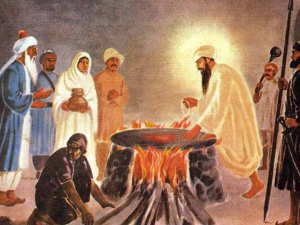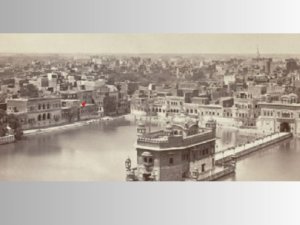From ancient times, we have been victims of caste and discrimination. Throughout history, various great individuals have made efforts to eradicate these discriminations. Even the Sikh Gurus worked tirelessly to guide us and eliminate these feelings from within us. Unfortunately, we have not been able to eradicate this poison of caste from within ourselves, and today this cancerous disease of caste is growing day by day.
The rulers of the time took full advantage of this, which made it easier for them to enslave us. Before the time of the Sikh Misls, and during the time of the Sikh Misls, and even during the reign of Maharaja Ranjit Singh, when he unified all the Misls into a large Sikh kingdom, many blacksmiths, carpenters (later known as Ramgarhias), and other castes were significant landowners in Punjab. While Jat landlords primarily engaged in agriculture, many blacksmiths, carpenters, and masons also worked in both agriculture and their ancestral crafts. These blacksmiths and carpenters were substantial landowners in large villages and areas.
Punjab under the British rule
From ancient documents, we gather some information, which we will certainly consider. In 1839, when Maharaja Ranjit Singh passed away, the British began to enter Punjab. Soon, they occupied the entire Punjab. There is no doubt that some selfish and greedy people of Punjab fully supported the Britishers. They flattered the British government for their own convenience.
When the British completely took over Punjab politically, they also wanted to enslave us religiously to weaken us. Various laws were created to take control of our religious places. At one point in 1877, it was even decided to auction Sri Darbar Sahib (Amritsar), but fortunately, that scheme did not succeed due to Guru Ram Das Ji's grace. Then, in 1900, a new law was made to create discord among us on caste lines and to weaken us, known as the Punjab Alienation of Land Act 1900.The act was braught at the time of Lord Curzon. The general narrative was that landlords and moneylenders would take over the lands of innocent people by giving them loans. But the real intention was to create division among Punjabis and collect maximum revenue (tax) for the British government. Most of these moneylenders were Baniyas, Khatris, Mahajans, and some large Jat landlords.
According to this law (Punjab Alienation of Land Act), only Jat landlords could own agricultural land, and non-landlords (blacksmiths, carpenters, masons, Khatris, Mahajans, and other similar communities) were deprived of land ownership rights. According to Section 3 (1, 2, 3) of this law, both the seller and buyer of land had to belong to the landlord or landlord community.
If the buyer belonged to a non-Jat landlord community and it was necessary to make the transaction, permission had to be obtained from the district revenue officer. The revenue officer had the full authority to approve or reject the application.
The worst effect of this law was that the entire Sikh community was divided into two factions: Jat landlords and non-Jat landlords. Another significant change was that Jats began to see themselves closer to Hindu and Muslim Jats and started to view their Amritdhari Sikh brothers as separate. Under this law, many Ramgarhia brothers lost their lands. Similarly, the lands of many Sehajdhari Sikh farmers were also taken away. Jat landlords saw this as a major victory and began to consider non-landlords as inferior. The damage caused by this can still be seen today. Many non-Ramgarhia organizations at the time saw themselves as special allies of the British and occupied major government and other high positions.
At the time this law was made, Raja Sir Harnam Singh Ahluwalia of Kapurthala, who was only one a member of the council, opposed it. However, the Sikh organizations that were dominant in the Sikh community at that time supported the British. Dr. Gokul Chand Narang, in his book "Transformation of Sikhism," writes that the most powerful Sikh organization of the time was the Singh Sabha movement. If it had united the entire Sikh community and opposed this law as a strong force, it could have been stopped. But they remained silent, perhaps not foreseeing the long-term consequences of this law, which would once again entangle the Sikh community in the same caste system from which the Tenth Guru had liberated us. However, even within that organization, the influence of Jat landlords was probably stronger.
Mainly the capital of Punjab was at Lahore, but in British period the summer capital was always moved to Shimla. This act alerted the all non cultivating communities. In 1902 a monthly paper was started from Lahore with the name : (Ramgarhia Patrika ). This newspaper has braught the awareness in all ramgarhias too. The head of Bagria cast S. Arjun singh bagria also owns thousands acre of land which was confiscated by this law.
14 June 1908 there was a big meeting held of ramgarhias and Ramgarhia sabha Punjab was fouded.
1922 the news paper with the name “ Ramgarhia gazette” was started from Shimla. These both news papers Ramgarhia Patirka and Ramgarhia gazett worked realy hard to bring the awareness about this black law among Ramgarhia brotherens. A big coferance was held at Lahore and “ Ramgarhia central Board” was founded. The meetings were held in all over Punjab and out side punjab state to spread the awareness and to raise the voice against this law. In 1931 S.Ishar singh along with Dr. Nand singh seehra and Kulwant singh Contractor met the Governor of Punjab related to this subject. Even in 1933 The governor of Punjab came to Phagwara personaly to meet Dr. Nand singh seehra.
In 1940 some prominent Ramgarhia personals started visiting the near and far villages to spread awareness and to make a unity of people against this law.
We should also be thankful to the Ramgarhia Sabha Shimla for starting a strong opposition to this black law in 1913. They began collecting government statistics. Although this law was repealed in 1946-1947, no changes were recorded in government records for Sikh farmers, nor were they included in the cultivator category. Cases were filed in the Shimla High Court. To pursue this case, many dedicated Ramgarhias even moved their businesses to Shimla. This struggle continued for a long time, and finally, in 23 June1950, they succeeded in their mission.
Here is some information and government statistics obtained through Ramgarhia Sabha Shimla Gazette :
In 1913, Ramgarhia Sabha Shimla presented a memorandum to Sir Umar Karaj, detailing the land ownership and significance of the Ramgarhia community.
In 1939, through S. Teja Singh B.A., Secretary of Young Men Ramgarhia Association Lahore, these statistics were presented in the Punjab Assembly through Nawab Muzaffar Khan.
Statistics collected by district patwaris and tehsildars of ten districts presented to the Punjab government included the following areas: Hoshiarpur, Dasuya, Garhshankar, Una, Jalandhar, Nakodar, Phillaur, Nawanshahr, Lahore, Kasur, Moga, Chunian, Zira, Ferozepur, Muktsar, Fazilka, Ajnala, Amritsar, Tarn Taran, Batala, Gurdaspur, Pathankot, Sialkot, Shakargarh, Narowal, Pasrur, Daska, Ambala, Ropar, Kharar, Ludhiana, Narayangarh, Jagadhri, Jagraon, Samrala, Sheikhupura, Shahdara, and Nankana Sahib.
Total landowners in these areas:
- Ramgarhia Sardars = 30,545
- Marus = 8,028
- Jagirdars = 127
- Mafidars = 38
- Numberdars = 63
Examples of lands confiscated:
- In 17 villages of Lahore: 494 acres, 2 kanals, 4 marlas
- In 12 villages of Amritsar: 720 acres, 7 kanals, 13 marlas
- In 67 villages of Gurdaspur: 840 acres, 3 kanals, 17 marlas
- In 20 villages of Hoshiarpur: 260 acres, 2 kanals, 10 marlas
- In village Sikhwala of Ferozepur: 1,552 acres
- In Bagarian: over 1,000 acres of land went from Ramgarhias.
This struggle continued, and finally, the government had to grant equal rights to the Ramgarhias.
The decision of Lahore High Court:
"Ganda Singh vs. Dassaundha Singh and others A.I.R. 1931 Lahore 637 page 640 – (The blacksmith and carpenter belong to the original class. Although their ancestral profession can be said to be carpentry and blacksmithing, they are more closely aligned with the landlord classes)."
Senior Sub-Judge Sheikhupura S. Bhagat Singh B.A.P.C.S.'s 1943 decision:
"Blacksmith and carpenter are made of the landlord classes, whose ancestors made carpentry and blacksmithing their auxiliary profession along with agriculture. (Without this craftsmanship, agriculture would have never been possible, : author). During the time of the Sikh Misls, their Misl was Ramgarhia, led by Sardar Jassa Singh Ramgarhia. Ramgarhias fall under the landlord law. Hindu Dharma Shastra does not apply to them."
Mr. Hardy I.C.S., District and Additional Sessions Judge, in 1944, during the appeal by the opposition, upheld the 1943 decision of Sub-Judge Sheikhupura and dismissed the appeal.
(Ramgarhia Sabha Shimla obtained this information from the book "Glimpses of Ramgarhia Glory")
Notifications regarding Ramgarhias as cultivators:
- Shimla-East, Friday, June 23, 1950, Department of Revenue's June 1950 notification number 4797-R.-50-3464, using the powers given under the Fourth Part of the Punjab Alienation of Land Act 1900, the Governor of Punjab is pleased to declare that the group of people known as Ramgarhia shall be considered "agriculturists" in all districts of Punjab from today.
- Every individual of the Ramgarhia community residing in Punjab shall be considered "agriculturists" under this law.
- In all districts of Punjab, the Ramgarhia community will be counted among "A-District communities."
Signed: Raghubir Singh Deputy Secretary, Government of Punjab - Department of Revenue
Note: Due to the efforts of Ramgarhia Sabha Shimla, the Punjab government, in their notification number 6309, R. 50-5007 dated September 20, 1950, removed the word "Sikh" from the Ramgarhia title and declared all Ramgarhias, Hindu and Sikh alike, as "agriculturists."
PEPSU Notification:
Department of Revenue Notification number 314-B-50-11-50 Patiala, February 1950. Using the powers given under the Fourth Part of the Punjab Alienation of Land Act 1900, the Raj pramukh is pleased to declare that the group of people known as Ramgarhia shall be considered "agriculturists" in all districts of PEPSU (Patiala and East Punjab States Union) from today.
Deputy Secretary, Patiala and East Punjab States Union
Thus, the persistent efforts of Ramgarhia Sabha Shimla resulted in the Ramgarhias being granted equal rights. However, the adverse effects of the discriminatory law, the Punjab Alienation of Land Act 1900, continued to impact many Ramgarhias. The ultimate conclusion is that we must learn from this history and work to root out the poison of caste from within us, striving to become true followers of the Sikh Gurus.
References:
- "Transformation of Sikhism" by Dr. Gokul Chand Narang.
- "Glimpses of Ramgarhia Glory" by Hazara singh Assi ( 1951) Shimla.
- Ramgarhia Gazette Shimla ( News Papers ).
- Punjab Alienation of Land Act 1900.
- Tawarikh Ramgarhia ( Dr. Amarjit Kaur Bamrah )
Conclusion:
In conclusion, it is evident that the struggle of the Ramgarhias for their and other non cultivating community rights was long and arduous. The caste-based discrimination they faced was deeply entrenched and legally sanctioned by the British colonial administration. However, through persistent efforts and legal battles, the Ramgarhia community was able to secure their and other non cutivating community rights as cultivators and landowners. This historical struggle highlights the importance of unity and resilience in the face of discrimination and serves as a reminder of the need to eradicate caste-based distinctions within the Sikh community and beyond.




